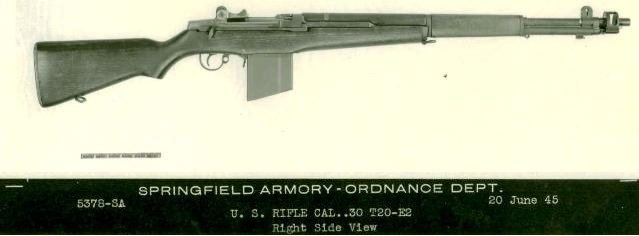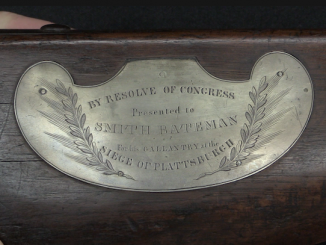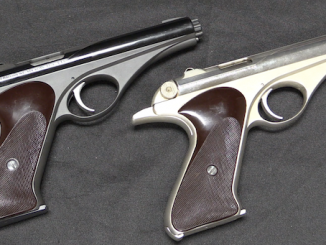Here’s a question: considering that by 1945 John Garand had developed working prototypes of the T20 rifle (basically an M1 with a select-fire trigger mechanism and a 20-round box magazine), why did it take the Army until 1957 to actually adopt the M14 (basically an M1 with a select-fire trigger mechanism and a 20-round box magazine)?

Really, does it take 12 years to modify it with a slightly different gas system (which had also already been more or less developed for another experimental M1 variant)? And after all that time, why would manufacture be laden with problems? Wasn’t the whole point that the M14 was just a tweaking of the M1 that could be made using existing tooling and expertise?
The answer to these questions shouldn’t really be a surprise, is it comes under the general heading of how a government bureaucracy can completely screw up even the simplest project through sporadic funding, contradictory and changing design requirements, ignorance, and politically-motivated self-sabotage. Edward Ezell’s book The Great Rifle Controversy is a really interesting read on this subject, starting with the initial adoption of the M1 (which nearly didn’t happen, thanks to cartridge-choice disagreements) and proceeding through the M14 development and adoption and into the M16. It is a repeating story of some brilliant and well-intentioned engineers trying to negotiate a minefield of politics, international diplomacy, traditionalism, and seemingly random obstacles to bring their ideas to fruition.
This is not a book written for the New York Times best-seller list, it is intended for folks who already have a decent understanding of firearms. If you have an M1, M1A, or AR-15 and have any interest in how they managed to survive through to military adoption, it’s a great book for you. Ezell gives a very good explanation of the circumstances and parallel projects surrounding each of these weapons, which must be recognized before one can really understand the history of the final product of the process. These generally-forgotten side projects include subjects like:
- Development and subsequent abandonment of the .276 Pedersen cartridge
- Post-WWII development of Earle Harvey’s T25 rifle
- NATO standardization efforts in the 1950s, involving the EM2, FAL, and M14
- Small-arms stagnation in the Korean War
- The SALVO studies questioning the actual effectiveness of individual marksmanship
- The SPIW program to replace the M14 with a flechette rifle
- Air Force and ARPA use of the AR-15 in Vietnam
And really a whole lot more. For most readers, this book will illuminate vast fields of the behind-the-scenes history of the most iconic US rifles. Even folks with substantial firearms knowledge and expertise will find things they had not realized, and answers to nagging questions.
Ezell is a perfect person to explain these recurring stories, as former supervisor at the Smithsonian Institute and Curator of the National Firearms Collection. He wrote this work back in 1984, as an expansion of his PhD thesis on the subject (a doctorate in the history of gun design; that’s our kind of people!), and went on to produce several more outstanding volumes on the AK and AR as well as a modern revised edition of Small Arms of the World until his death in 1993. Despite the amount of information contained here, Ezell’s writing is clear and readable. Unfortunately, The Great Rifle Controversy is no longer in print, and the least painful price I can find for it is just under $100 on Amazon. It might well be worth that to a few folks, but for the rest of us I suggest grabbing a copy on inter-library loan: WorldCat says there are 157 libraries in the US that own it. You can also keep an eye out for it at gun shows – that’s how we got our copy for $8.




That’s funny because I just saw a youtube clip of a guy that had converted his Springfield M1 to accept BAR mags. I can only image how awesome, logistically, if every infantryman would carry BAR mags during the Korean war.
Yeah, the upgraded Garand was a fall-back for if the T25 program failed. The T25 was a very good design, and I’m not entirely sure they let the program collapse on itself, but they did.
Any way I can get the book at a reasonable price? The lowest Amazon price is $100.
Since it’s out of print, your best bet is to find it from a used book dealer at a gun show. Or, of course, have your local library get a copy in for you.
Is there any differences between the development of the T20 and the BM59
I don’t know that much about development of the BM59, so I can’t really give a good answer.
The obvious difference is that the BM59 was chambered in 7.62mm NATO and used converted M1 receivers. The T20 was chambered for .30-06 and used a longer receiver than the standard M1. When the Ordnance Department starting playing with full-auto M1 conversions during WW2, it was quickly found that the higher cyclic rate of a converted M1 vis-a-vis the BAR meant that the spring of a standard BAR magazine couldn’t keep up. The receiver was lengthened in the T20 in hopes of giving the magazine a chance to keep pace, but ultimately, a proprietary magazine had to be designed. The only saving grace was that the T20’s magazine would work in the BAR. The other significant difference of the T20 was that it introduced the M1E3’s roller lug that was later adopted for the M14. Ordnance had previously wanted to adopt the roller lug for the M1, but didn’t want to stop the existing production lines to introduce the new bolt and operating rod that would be required.
Hard to say: not much about the BM59’s development has been written at all, let alone translated to English from Italian! But chances are the Italians rec’d. copious details about the parallel developments of the T20 [John Garand’s attempt at a mag-loaded full-auto M1 variant.] Among those details would have been the need for a slightly longer receiver to address timing issues for full-auto operation. The advent of the shorter 7.62x51mm NATO round by the time the BM59 was developed would have meant that the existing pattern M1 receiver would have been able to be retained w/o issue, allowing the Italians to field a product improved M1 in a fraction of the time the U.S. required to develop, discard, develop, discard, & finally revert to redeveloping a new, shorter M1 variant.
there’s a very interesting book, called “Random shots” by Robert Roy, who worked at Springfield Armory during M14 / M60 times. Well worth the read.
Yes, I concur. You can actually read that one on Google Books: http://books.google.com/books/about/Random_Shots.html?id=FxF8CMXoHGIC
The FAL was the better rifle, but the Ordnance Board had a bad case of the ‘NIH’ disease and wanted something that could be produced on existing machinery at SA. Tests were rigged against any non-American rifle (as they were rigged against the M16 – (which is a whole ‘nother story). A good book to read is “Misfire” by William Halloran – the history of mistakes and malfeasance by the Ordnance Board throughout American Military History and why the US went into so many conflicts with out proper & sufficient weaponry. The 7.62×51 ctg is a fine round, but NOT the one needed at the time the M14 was accepted…the 8×33 Kurz had turned the military weapons world on its head and the US refused to see…
CB in FL
If the FAL in .280 had been adopted at the time, we might STILL be using them.
I seriously doubt that, Magus. The .280 is much, much closer to 7.62mm than it is to 5.56mm; the arguments for 5.56mm against 7.62mm still apply to the .280, as well.
If the atomic bombs had not been dropped, the T-20 and the .30-06 MG-42 clone would have gone up against Japanese Girl Scouts with bamboo spears…
Why?
The Japanese state had been trying to surrender since at least January 1945,
Diplomatic approaches were made through at least the following states and maybe more:
Switzerland, Soviet union, Portugal, Vatican
The only supposed sticking point was the emporer – supposed, because in the event he was allowed to remain,
So in terms of post war events, the war in the Pacific could have finished with the same outcome, without use of nukes, in January 1945.
Even without that offer of surrender, there was total air supremacy over Japan, supplies of oil and other fuels were next to zero, there was no risk of a break out, and no need to invade.
Sorry to resurrect this thread, but I just pulled up the PDF of Ezell’s dissertation. It is available for free through any library that subscribes to a service called Proquest Direct. Any university library has it, and I bet the reference librarian at your local library can log you into it too.